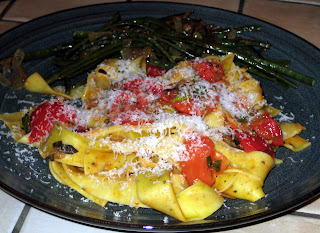I came across
this recipe and blog today, searching for something (probably lentil recipes, go figure), and thought it looked delicious enough to try. Plus, it calls for cherry tomatoes, and I had a basket sitting on the counter getting perilously close to going all mushy. Plus #2, he uses "glug" as a unit of measurement (as in, "saute with a good glug of olive oil") and I felt instantly that we must be kindred measuring spirits. Or maybe this is more common practice than I thought. But most (pre-blog) recipes I've written down have the words "glug," "handful," "liberal dousing" and "more than you would think" in place of more, um, traditional (read: normal) measurement terms, and given that apparently
legitimate people do this too, I am seriously considering dropping all this tablespoon business in favor of my typical haphazard approximations. Feel free to lodge a complaint if you like the safe precision of quarter teaspoons. I get all excited when people leave comments.

Back to lentils: I suspect the original version is delicious, but I didn't have smoked paprika and did have some other things, so an adapted version is below.
Ingredients
Olive oil*
Small yellow onion, chopped
3-4 cloves garlic, pressed
Scant 2 cups beluga lentils, picked over and rinsed
1 cup organic vegetable broth
Sherry vinegar
Spanish sweet paprika
Aleppo pepper
Ground cumin
About a pound of mushrooms, half crimini and half shiitake, brushed and halved or quartered (depending on the size)
2-3 large handfuls amaranth greens, coarsely chopped (could substitute 2 handfuls spinach)
Salt & freshly ground black pepper
2/3 basket cherry tomatoes, halved
Basil chiffonade (6-7 leaves, rolled & thinly sliced)
Saute the onions in a pot over medium heat for 2-3 minutes until slightly softened, add garlic, and cook for an addition minute or two. Add the lentils and stir to coat with the onion-garlic mixture, then add the broth and 2 cups water. Cover, bring to a boil, and turn heat down to low. Simmer for 25-30 minutes or until just tender, stirring every ten minutes or so. (If you don't want to stir, add an additional cup of water at the beginning and then drain the lentils after they're done. I don't like having to drain them, so I often use less liquid, but this does mean you have to stir more frequently and it probably takes a little longer to cook.)
Turn off heat and add 1 1/2 tsp sherry vinegar, 1 tsp paprika, a spoonful of Aleppo (or adjust spiciness to taste), and a pinch or two of salt. Liberally dust with cumin, stir, and taste. Adjust seasonings if you'd like it to have more tang or more spice.
Meanwhile, heat a pan over high heat until very hot. Add a generous metric glug of olive oil and let that heat up too, then add the crimini mushrooms. Turn the heat down to medium-high and brown the criminis on each side. When they're about halfway done, add the shiitakes as well (these will cook more quickly). When the mushrooms are browned and just tender, add the amaranth greens and stir-fry for about a minute or until just wilted. Turn off the heat and season with salt and pepper.
In a small bowl, combine the cherry tomatoes, basil, about 2 tsp sherry vinegar, a slosh of good-quality extra virgin olive oil, and some black pepper.
Serve (lentils first, then the mushrooms, with a couple spoonfuls of the tomato-basil mixture on the top).
To round off the meal, add a crusty loaf of fresh bread (get something whole wheat and/or seeded if you want to make a complete protein, and skip the twenty-billion-ingredient variety in favor of something straightforward if you're going the Pollan route) and a glass of Spanish wine (pairs well with a
2007 Juan Gil Jumilla, currently on sale at Costco for a crazy low $11/bottle).
Serves 4, or 2 for dinner with leftovers for lunch the next day.
*Incidentally, a ridiculous number of major brand olive oils are
not actually extra-virgin as claimed...see p. 10 of the
report from UC Davis to see whether yours is.














































